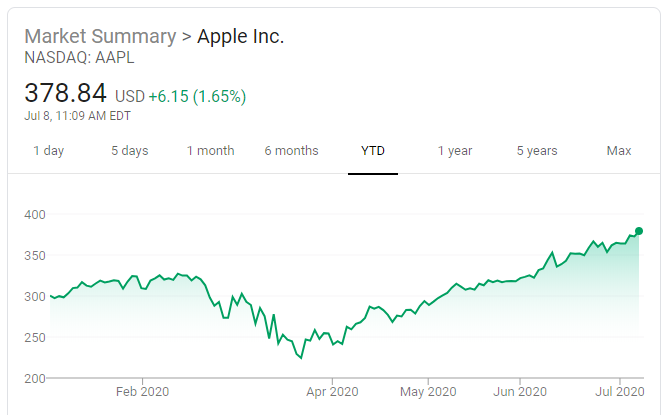Apple (AAPL) stock has long been a stock market darling, but investors have generally been rational with their pricing of the shares relative to the company’s profits. At the end of each of the last 5 fiscal years, AAPL stock has garnered trailing 12-month price-to-earnings ratios of 19, 19, 17, 14, and 12, respectively (the most recent year, 2019, is listed first). Over the last few years, the market has slowly adopted the bullish thesis that Apple is more of a consumer staples company (a valuation at or above the overall market) than it is a hardware company (a valuation well below the overall market).
But something has changed as the pandemic shapes 2020 thus far. Here is the stock performance year-to-date:
Having started the year at $293 per share, Apple stock has now gained 30% so far in 2020. Has the pandemic boosted their business somehow? Obviously not. The current earnings forecast for fiscal 2020 is $12.40 per share, up mid single digits from the $11.89 they earned in fiscal 2019. The stock’s trailing P/E, assuming they do in fact earn $12.40 this year, has surged from 19 to over 30. The sentiment shift has occurred in just the last two months, despite the fact that the underlying business is essentially unchanged.
The only logical explanation to me is that momentum-driven trading action is sending popular tech stocks to the moon and another valuation bubble is likely forming. Apple’s revenue this year is projected at $264 billion, versus $260 billion in 2019 and $265 billion in 2018. Their business is simply not enjoying an acceleration of growth that would normally cause this type of P/E ratio expansion.
The scariest thing to me is that Apple actually looks cheap on the relative basis compared to other beloved tech stocks right now. For instance, Amazon stock recently crossed $3,000, attaining a market value of $1.5 trillion (joining Apple in that group). Despite the pandemic, Amazon’s earnings are actually expected to fall in 2020 due to outsize growth in expenses. Therefore, being generous and using their 2019 earnings per share of $23.01 puts Amazon’s P/E ratio at an incredulous 131.
And yes, it gets worse. You have the money-losing tech stocks that are getting multiples of revenue that exceed the earnings multiples of many leading American firms. Take DocuSign (DOCU), a leading provider of electronic signature software that is obviously seeing plenty of demand during the pandemic. For the quarter comprising February, March, and April (the height of the pandemic; their “Christmas” so to speak), DocuSign reported revenue of $297 million (up an impressive 39% year over year) and somehow managed to lose $48 million in the process. After more than tripling in price off the March lows, DocuSign’s market cap of $37.3 billion comes out to a price-to-sales ratio of above 31 (if we annualize last quarter’s results). It makes Apple at 30 times profits look darn cheap, doesn’t it?
There are plenty of other examples that most of you are aware of so I will spare you from citing more. This momentum-based market for flashy high-tech is eerily similar to 1999. Back then we were also valuing companies on sales (20-25x multiples were common) because there were no current earnings, only hopes and dreams of a bright cash cowing future. Amazingly, the revenue multiples are higher now in many cases than they were back then. And for leading firms that are making money, Cisco, Sun Microsystems, Nortel, and Intel at 80 or 100 times earnings 21 year ago does not look as egregious as the likes of Amazon or Tesla today.
I have no idea how this will play out, but having seen something similar firsthand in the 90’s, it makes me nervous. I have no intention of putting client money or my own into things trading at such sky-high prices. I will leave that to the new Robinhood crowd.

